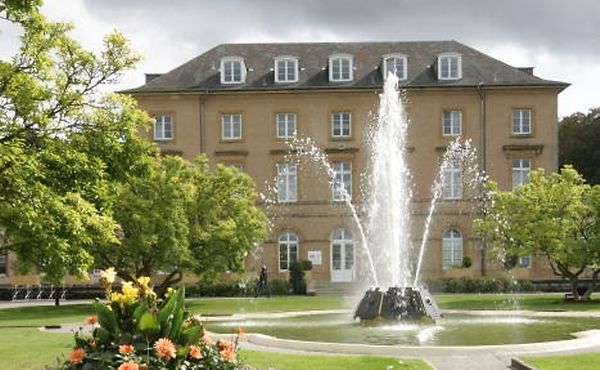Château de Walferdange, located just north of Luxembourg City outside the town of the same name, is one of the few castles with distinct ties to the Grand Duchy's Dutch rulers. The property was built sometime between 1817 and 1824 by Grand Duke Willem I (who was also King of the Netherlands) as a stud farm. However, Willem never visited the farm or even the Grand Duchy itself, where he was generally not very well-liked. Willem I was forced to abandon Walferdange after the 1830 Belgian Revolution in which much of Luxembourg joined in rebelling against Dutch rule. From the outbreak of the revolution to Willem's abdication in 1840, Château de Walferdange lay vacant.
 |
| The Château de Walferdange in 1834 |
Walferdange came to life again in 1840 with the accession of Grand Duke Willem II, the previous Willem's son and again also the King of the Netherlands. In contrast to his father, the younger Willem was popular in Luxembourg. He took a liking to both the Grand Duchy and to Château de Walferdange, ordering renovations to the home and grounds in preparation for use as a royal residence. Willem stayed at the château during several of his visits to Luxembourg.
Henry of the Netherlands, third son of Grand Duke Willem II, was Walferdange's longest royal resident. As the the very popular Governor of Luxembourg, Henry and his first wife Amalia of Saxe-Weimar-Eisenach lived at the château for many years after their marriage in 1853. The couple extended the grounds of the property, and took an active interest in village life. Henry and Amalia were especially loved by the local children, who received gifts from the couple at Christmas. Amalia died at the home in 1872 of a lung infection, leaving her husband and the Luxembourg public to mourn her.
 |
| Walferdange Castle, with the fountain in the foreground. (Photo: Luxemburger Wort / Wort.lu) |
Following Amalia's death, Henry continued to live at Château de Walferdange. He brought his second bride, Marie of Prussia, to live in the home after they married in 1878. A few months later, measles began to spread among the children in the village. Henry caught the disease in January 1879. Although initially the illness did not seem serious, Henry quickly succumbed and died at the château on January 14.
Henry had assured his young bride that his will and other important documents were stored in a safe at Walferdange. Henry claimed to Marie that a new will was drawn up after their wedding, leaving the bulk of his massive estate to her. However, no will was found at the castle after Henry's death, allowing for a previous will to stay in effect. This left his siblings richer and Marie destitute. Marie pursued the matter in court but ultimately remained empty-handed; relations between the Netherlands and Prussia soured for years in the aftermath.
In the two decades following Henry's death, the château remained unoccupied. The commune of Walferdange used the home as a post office and even as a fire station for a time until Grand Duke Adolph rediscovered the property at the beginning of his reign. Adolph ordered renovations on the home, adding greenhouses and expanding the grounds to accommodate for better hunting. Adolph and his family used the property as one of their many summer homes, serving wine to their guests from Walferdange's own vineyards.
 |
| Walferdange Castle today (Photo: Chronicle.lu) |
Since that time, Château de Walferdange has been purposed strictly for use in education within the Grand Duchy. In 2003, the property officially became part of the University of Luxembourg's campus in Walferdange, housing the Faculties of Language and Literature, Humanities, Arts and Education. Recently, however, the property has passed into the hands of the Ministry of Education. The château and its grounds will house a private school during the 2015-16 school year and later be the home of smaller programs servicing visually impaired students and the Luxembourgish Online Dictionary, among others.

No comments:
Post a Comment